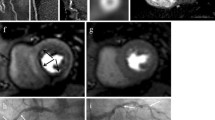4. Conclusions
The presented MR approach reliably identifies patients with anatomically and hemodynamically signiticant coronary artery stenoses. This is due to the fact, that the pulse sequence used produces a substantial change in signal intensity in the perfused versus poorly perfused myocardial regions. Analysis of upslope in this setting rather than of other parameters provides a very sensitive and specific measure of myocardial ischemia. As upslope is a semiquantitative measure of absolute perfusion, even patients with triple vessel disease may be evaluated using this method. This is not the case when using conventional nuclear techniques. Furthermore, the spatial resolution of the MR images permits one to resolve the subendocardial layers of the myocardium, which thus can be evaluated separately from the entire wall. Again, this is not possible using nuclear cardiology perfusion imaging. The robustness of this MR perfusion imaging approach and the fact, that most of the heart can be covered may qualify for its clinical application in the management of coronary artery disease.
Similar content being viewed by others
Author information
Authors and Affiliations
Corresponding author
Rights and permissions
About this article
Cite this article
Schwitter, J., von Schulthess, G.K. MR perfusion imaging: correlation with PET and quantitative angiography. MAGMA 11, 71–72 (2000). https://doi.org/10.1007/BF02678500
Received:
Accepted:
Published:
Issue Date:
DOI: https://doi.org/10.1007/BF02678500




